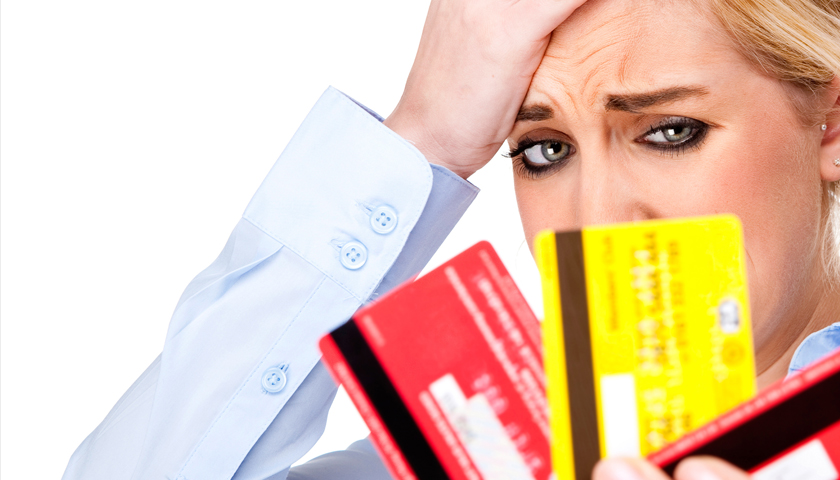Is a Credit Card Crisis Underway
Yes. And this is only the beginning. They call it a credit card, a small plastic card that allows the holder the ability to obtain goods or services before actual payment, based on the trust that payment will be made in the future. Some call it a lifeline, some call it a handy and convenient tool, and others call it a big problem. Considering inflation, lowering or stagnant wages, varied unemployment, the various bubbles which are emerging, and so on, red flags are starting to fly at the amount Americans have been charging.
The psychology is simple: cash is tangible. It is a piece of paper with perceived value. As you spend it, you have less of it. You can see your stack diminishing, and you can process this as “running out” and act accordingly. Cards are different. You do not see a dwindling pile with a small plastic card. You use it over and over and see the result of your decisions at the end of the month. This is actually a big problem for some.
A 2012 study by Promothesh Chatterjee and Randall L. Rose saw that consumers who use credit will focus on the product’s benefits as opposed to their costs. According to a study by researchers at Carnegie Mellon, Stanford, and MIT, “Credit cards effectively anesthetize the pain of paying,” said George Loewenstein, Carnegie Mellon professor of social and decision sciences (SDS) and co-author of the paper. “You swipe the card and it doesn’t feel like you’re giving anything up to make the purchase, unlike paying cash where you have to hand over bills.” McDonald’s even reported its average ticket went from $4.50 to $7 when people use credit cards versus cash. Additionally, experimental research being conducted suggests that credit cards can stimulate overspending. In some cases, people are often willing to pay more for the exact same product when using credit than when using cash.
Spending more, getting less; this is never good. In 2015, the average household had $132,086 in debt — $15,310 of it was on credit cards. Things were looking better for a while, but this year, American consumers have racked up $34.4 billion in credit card debt during the second quarter alone, representing the largest second-quarter accumulation since at least 1986. In fact, outstanding credit card balances are on track to rack up $1 trillion by the year’s end. That’s a trend personal finance site WalletHub calls “very ominous.”
Jill Gonzalez, an analyst at WalletHub said: “I’m not saying we expect a recession by the end of the year, but it’s scary to see this credit card data and how similar it is to what we saw pre-recession.” Consider that consumers only paid down $27.5 billion of their credit card debt during the first quarter, the lowest first-quarter pay-down since 2008. “As a result, it’s not a question of whether consumers are weakening financially, but rather how long this trend toward pre-recession habits will last and just how bad it will get.”
What I find particularly worrisome is the bad analysis going on in regard to these trends. For example, Benjamin Lupu, a certified financial planner at Kensington AMI, recently said that the rise in credit card debt isn’t necessarily a sign of spending gone wild. He says that it is because more people are using credit cards to pay routine household bills, such as utilities, cell phones, and Netflix, than they did a few years ago. He says it’s a way to collect points and credit card perks.
That’s one to look at it, I suppose, but I do agree that cards are being used for bills. Let us put this into perspective. Recently, red flags have begun to wave from economists and media alike about sub-prime borrowers in regard to car loans. People missing payments within a few months of the vehicle purchase has been the focus, but the issue seems to be widespread. This is being called a crisis because of how closely it resembles markers surrounding pre-recession in regard to mortgages.
Student loan debt is also being called a crisis. Student loan debt exceeded credit card debt in 2010 and auto loans in 2011, and it passed the $1 trillion mark in 2012. Data from the Baccalaureate & Beyond Longitudinal Study found that the percentage of bachelor’s degree recipients graduating with excessive debt grew from 9.8% in 1993-94 to 14.4% in 2007-08. Estimates today put more than 25% of students who take on college debt and are graduating with excessive debt – this is on top of all of those who still carry debt from the early ’90s and 2000s.
So if student loans are considered a crisis and auto loans are considered a crisis, then consider this: grumbles about a recession over credit card debt are already occurring because credit card debt is about to hit a trillion dollars by the end of the year. Well, auto loans are already at about $1.07 trillion, and student loans are at about $1.26 trillion. Furthermore, in its 2016 Financial Literacy Survey, the National Foundation for Credit Counseling found that one in three U.S. households carry credit card balances from month to month, with 14 percent indicating that they roll over $2,500 or more in debt. Factor in the bigger picture, and it’s easy to see what this all means.
Some point to consumer confidence as the reason for this credit card debt spike. I find this unlikely, considering many other economic indicators. Still, the question I want the answer to is exactly how many of these people have a student loan, an auto loan, or a low-paying full or part-time job as their primary source of income and are forced to use their credit card to pay their bills? Something tells me that that number might be shocking.
Be sure to get the update by reading my article titled, “Economic and Projection Model Updates.”




